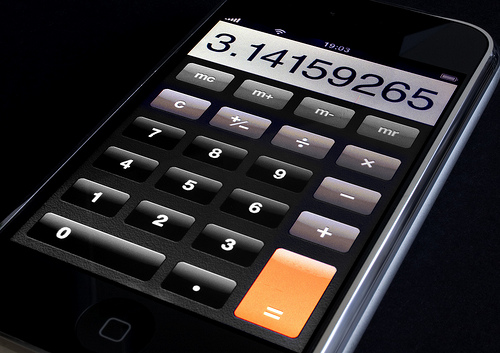Budgeting Tips for Generation Y

Photo credit: Dominic’s Pics
Too many twenty-somethings are beginning their adult lives unprepared to make sensible financial decisions. But that doesn’t have to be your story. Although you’ve got a built-in disadvantage if you weren’t taught the basics of personal finance or how to budget in school, that doesn’t mean you can’t learn how to do it. So here’s an approach to managing a home budget for a generation just starting out with money management.
Appliances: Not a Given Anymore

Photo credit: iLoveButter
If you just purchased a home or moved into your first unfurnished apartment, you’ve already gotten the message. The common, taken-for-granted appliances mom and dad always provided (refrigerator, stove, microwave, etc.) must now be purchased by you. When these necessities have been provided for most of your life, it can be difficult motivating yourself to buy them for yourself.
Many younger adults make little effort to plan ahead or budget for these items. Instead, they just turn to credit cards and wash their hands of the matter entirely. According to MSN, “…the median credit-card debt of low- and middle-income people aged 18 to 34 is $8,200″—and that excludes student loans. However, this is hardly the type of intelligent spending that helps young adults get their financial life started on sure footing.
The correct approach is to acknowledge (preferably before moving out) that you will need home appliances and budget for them just as you would other expenses. Unless you are a complete financial wreck, we’re willing to bet your cell phone bill, NetFlix subscription and car insurance gets paid like clockwork every month. That’s because these bills carry direct, immediate consequences for not paying them. In order to properly budget for home appliances, it is best to save for them in this same way. That is, shop around for the appliances you will need to buy, gather prices, and save a certain amount each month toward the costs.
If you opt not to pay for appliances up front (many stores offer payment plans), you must still account for the monthly payments in all of your future spending. It’s called financial planning and it’s the kind of thing software tools like Quicken can help you with. These online personal finance tools can show you where you are spending your money and also help you set a realistic budget for the true necessities of everyday life.
For instance, if the combined cost of bringing home a refrigerator and stove will add another $500 in monthly payments to your budget, this should be planned for in advanced rather than haphazardly adjusted to later on. It may turn out that these extra costs pinch your spending in other areas, like entertainment. You will be less likely to blow off your bills (and go into debt) if you are aware of this going in than if you fall out of bed one day and suddenly realize you can’t go out for drinks as much as you used to.
Another key item you will likely need to buy are housewares. Unless mom and dad sent you packing with their stuff, you’ll need to budget to buy silverware, cookware, bowls, plates and small appliances.
Buying These Items For Less

Photo credit: acloudman
Of course, not all of these major household items need to be purchased brand new from a store. In fact, this may not even be the preferred path for most of Gen Y. SteadfastFinances.com reported in January 2010 that Gen Y is “…developing a preference for used stuff,” citing a recent study which showed that the under-40 crowd was more likely to buy used laptops, buy used cars on Craigslist and hunt for deals online before dropping big bucks at a major retailer. This has definite implications for starting a home budget.
As the age group more comfortable with the Internet and technology than any other, there is simply no excuse not to get good deals on housewares and home appliances. More often than not, a used product can be found on the Internet that performs just as well as a new one for much less money.
That said, it’s important to do your homework before jumping on the first “deal” you see. This is often easier said than done. An eBay search for “microwave” returned over 7,000. The main thing to be mindful of when searching for major household items on websites like eBay and Craigslist is seller dishonesty. While it’s possible to find amazingly low prices on brand new, premium items like flat-screen TVs and refrigerators, prices low enough to evoke suspicion can signal a scam. Stories about eBay and Craigslist sellers using inflated claims about their merchandise are less common than in past years, but it is still a concern.
To avoid being swindled, examine two things. First, the ratings of the seller. It’s not a perfect indicator (nor is anything other than receiving the merchandise as promised), but a seller with pristine ratings from other buyers over a long period of time is probably trustworthy. The second thing to look for is the difference between the retail price of the item versus the seller’s asking price. Again, it’s possible that someone is willing to sell you a brand new stove for less than half its current retail price because he abruptly lost his job, but the greater the difference between the retail and selling prices, the more curious you ought to be.
Timing Your Purchases to Known Sale Months

Photo credit: timparkinson
If you aren’t comfortable making such weighty purchases on Craigslist, you should still approach retail buying intelligently. A 2009 BillShrink.com article on the “14 Best Times to Make Major Purchases” reveals that the best time to buy appliances is September and October, when stores are under pressure to clear space for the new arrivals.
Indeed, this article points out that settling for last year’s model of an appliance can save hundreds of dollars, and knowing why these items are on sale gives you negotiating leverage with salespeople.
Computers are said to be cheapest during July and August, when manufacturers are running back to school sales and the end of Japan’s fiscal year coincides with pushing new product to store shelves.
April, May and December are the months to watch for cookware, while dining room sets become highly promoted in late October and early November and recliners and chairs see significant activity in May and June.
If you cannot wait until one of these times to buy the item in question (we’d hate for our readers to go without a stove until September!), it may be better to look around on eBay or Craigslist. Of course, many retailers still run sales throughout the year, due to everything from excess inventory to slowdowns in business in the store. The overall idea is planning your household purchases—whether that means waiting or buying used—rather than being bamboozled by salespeople or tempted by credit cards to “just buy whatever” and get it over with.
The Takeaway
We can’t exaggerate the importance of approaching a home budget with an overall game plan. But don’t worry. Every last detail of your financial future doesn’t have to be mapped out today. Don’t feel guilty about spending money to enjoy yourself. But do have a realistic spending plan before your back is against the wall and you are forced to somehow find a way to purchase big items for the first time.
Quicken has made the material on this blog available for informational purposes only. Use of this website constitutes agreement to our Terms of Use and Privacy Policy. Quicken does not offer advisory or brokerage services, does not recommend the purchase or sale of any particular securities or other investments, and does not offer tax advice. For any such advice, please consult a professional.


